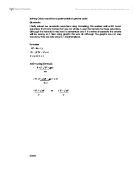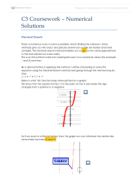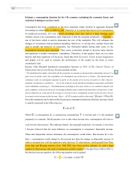C3 Mei - Numerical Methods to solve equations
C3 Coursework In this coursework, I will use numerical methods to solve the following equation, as I cannot solve it algebraically. I can only obtain an approximation of the solution as it is impossible or hard to find the exact value of the function. Decimal Search The graph below is the function I will use decimal search in order to find an approximation of one of the roots. The table below shows decimal search. Each boundary is tested for sign change which indicates that a root exists between them. The x where the sign change occurs in now the new boundaries and tested for sign change again. This method is repeated until an approximation of the root is found to a suitable number of decimal places. x f(x) 0 2 0.1 .9501 0.2 .8016 0.3 .5581 0.4 .2256 0.5 0.8125 0.6 0.3296 0.7 -0.2099 0.8 -0.7904 0.9 -1.3939 -2 x f(x) 0.66 0.011747 0.661 0.006295 0.662 0.000838 0.663 -0.00462 0.664 -0.01009 0.665 -0.01556 0.666 -0.02104 0.667 -0.02652 0.668 -0.032 0.669 -0.03749 0.67 -0.04299 x f(x) 0.662 0.000838 0.6621 0.000292 0.6622 -0.00025 0.6623 -0.0008 0.6624 -0.00135 0.6625 -0.00189 0.6626 -0.00244 0.6627 -0.00299 0.6628 -0.00353 0.6629 -0.00408 0.663 -0.00462 x f(x) 0.6 0.3296 0.61 0.277958 0.62 0.225763 0.63 0.17303 0.64 0.119772 0.65 0.066006 0.66 0.011747 0.67 -0.04299 0.68 -0.09819
Solving Cubic equations or polynomials of greater order
Solving Cubic equations or polynomials of greater order Quadratic I firstly solved our quadratic equations using factorising, this worked well until I found equations that have factors that are not whole. I used the formula for these equations, although the formula is very hard to remember and if it's written incorrectly the answer will be wrong, so I tried using graphs this was ok although the graphs are not very accurate, they are only around 1 decimal place. Factorise X² - 6x + 5 (x - 5) (x - 1) = 0 x = 5 or x = 1 Solve using formula - b +/- V b² - 4ac 2a + 6 +/- V 36 - 4 x 1 x -5 2 x 1 + 6 + V 56 or + 6 - V 56 2 2 Cubic Here I first tried solving the equations by factorising, as with the quadratic equations this worked well until I came across equations with factors including decimal places. For these I tried as before to use the formula but I firstly need to find one of the factors, and if all factors include decimal places this can be difficult. So I lastly tried to solve the equation using graphs, this was extremely hard as the cubic graph needs more detail and I found that the graph as before was only correct to one decimal place. This is not accurate enough for a cubic graph. Now, I have decided to go and look for other ways in which it would be possible to find all the factors of the equations which is accurate. I have now found a new
Design, make and test a Sundial.
Sundial Coursework Statement of Task: To design, make and test a Sundial. Introduction: The sundial is the oldest know device for measuring time. The first confirmed uses of it where by the Babylonians in around 2000BC. However it is safe to say that shadows have been used as a rough measure of time ever since primitive man discovered that as the day progresses the shadows of trees and rocks get shorter and then longer again. The sundials used by the Babylonians were hollow half spheres, set with edges flat and with a small bead at the centre. As the day wore on the shadow of the bead followed a circular arc, which is divided into 12 "temporary hours" (they changed through the seasons). A modern sundial consists of a plane (dial face) and the gnomon (style). The dial face is divided into hours and the gnomon is the flat piece of metal, or stick in the dials centre, it points towards the North Pole (in the northern hemisphere) or South Pole (in the southern hemisphere). The gnomon must tilt at the angle of the latitude at the location. Although a sundial seems like a simple device for measuring time, it is not. One cannot simply look at the shadow and find the time. Firstly the sundial will show local time, not GMT. Secondly we must allow for the 'equation of time.' Because the Earth's orbit is not circular, its velocity changes at the perihelion. To allow for this
Statistic: Is reading age a predictor for future attainment?
Statistic: Is reading age a predictor for future attainment? In this coursework I am going to investigate if reading age affects future results in KS3 Maths. I am going to consider gender differences. I believe that girls will make more improvement than boys because girls have a higher reading age than boys; I also predict that reading age will not be a predictor for future attainments. In order to collect my data fairly I am going to take a stratified sample because it will randomly select boys and girls, and won't give me a bias selection. I am going to collect a random sample by using my calculator and the random button. I pressed in the number of girls and boys (96 for girls, 143 for boys) I then pressed the random button which gave me numbers between 0 and the number of boys and girls which I then take down and draw up a table from it. I am going to present my data using the following statistical techniques a cumulative frequency diagram so it can show both discrete and continues data. Scatter diagrams, I can use that to show whether two sets of data are related. Box & Whisker plot of reading ages, mode, mean, median, and range, IQR to show me how the data is distributed. I will then do the same for the boys and girls. This will tell me which genders achieving well depending on their reading age. To summarise the KS3 Maths data I will use Bar charts, Pie charts mean,
Numerical solution of equations
Pure Mathematic 2 Coursework Numerical solution of equations By Michael Pang I am going to show 3 of the numerical methods for solving the equation which cannot be solved algebraically. They are interval estimation, fixed point estimation and Newton-Raphson method. Those of these numerical methods are used when algebraic ones are not available. When you found any equations which cannot be solved algebraically, probably you will draw the graph and see where the roots are. However, the other problem is found that you cannot get all roots accuracy. Actually, the numerical methods cannot find the exactly root but the answers are more accuracy than sketching the graphs. Therefore, we usually provide the answer to 5 or 6 decimal places depending on what the questioner needs. Finally, we check the answer by setting the lower bound and upper bound to see whether it has sign change or not. Even if the three numerical can solve the equation non-algebraically, they have its advantages and disadvantages. And now I am going to show how these methods works and their problems by using the equation F(x) = x³-9x+3. Interval estimation Assume that the roots of the equation F(x) = x³-9x+3, and I am looking for the roots which F(x) = 0. The roots of the equation are the values of x which the graph of y = x³-9x+3 crosses the x axis. By using the computer, I recognise that there are 3
Mathematics portfolio - Translations.
Man Ju Y12D Mathematics - portfolio Translations . 2. is the effect of translation vector of . It moves up 2 units. is the effect of translation vector of . It moves up 4 units. is the effect of translation vector of . It moves down 3 units. 3. + 3 is the effect of translation vector of . It moves up 3 units. -1 is the effect of translation vector of . It moves down 1 unit. 4. Curves move either up or down vertically. The units they move is according to the number after x2 in the equation . If the number is positive, the curve will be pulled upwards. If the number is negative, the curve will be pulled downwards. 5. f(x) = sinx -2 is the effect of translation vector of f(x) = sinx. It moves down 2 units. This has the same effect with the previous examples. The unit it moves is according to the number after sinx in the equation f(x) = sinx c. If the number is positive, the curve will be pulled upwards. If the number is negative, the curve will be pulled downwards. Therefore the generalization extends to any function f(x). 6. 7. is the effect of translation vector of . It moves right 2 units. is the effect of translation vector of . It moves right 3 units. is the effect of translation vector of . It moves left 1 unit. is the
OCR MEI C3 Coursework - Numerical Methods
C3 Coursework Change of sign (decimal search) Finding a root of an equation with graphical illustration f(x)=x3-7x2+2x+1 This is graph of y=x3-7x2+2x+1 The graph shows that roots of f(x)=0 exist in the intervals [-1,0]; [0,1]; [6,7] We shall test for a root in the interval [6,7] x f(x) 6.0 -23 6.1 -20.289 6.2 -17.352 6.3 -14.183 6.4 -10.776 6.5 -7.125 6.6 -3.224 6.7 0.933 Change of sign indicates root exists in interval [6.6,6.7] This means that x=6.65±0.05 x=7 (0d.p.) x f(x) 6.60 -3.224 6.61 -2.81992 6.62 -2.41327 6.63 -2.00405 6.64 -1.59226 6.65 -1.17787 6.66 -0.7609 6.67 -0.34134 6.68 0.080832 Change of sign indicates root in interval [6.67,6.68] This means that x=6.675±0.005 x=6.7 (1d.p.) x f(x) 6.670 -0.34134 6.671 -0.29924 6.672 -0.25711 6.673 -0.21496 6.674 -0.17278 6.675 -0.13058 6.676 -0.08835 6.677 -0.04609 6.678 -0.00381 6.679 0.038498 Change of sign indicates root in interval [6.678,6.679] This means that x=6.6785±0.0005 x=6.68 (2d.p.) X f(x) 6.6780 -0.00381 6.6781 0.000419 Change of sign indicates root in interval [6.6780,6.6781] This means that x=6.67805±0.00005 x = 6.678 (3d.p.) Failure of the decimal search Two of the roots of f(x)=0 where f(x)=5x3-20x2+2x-0.05 could not be found with this method. This is because they are so close together that there is no sign change
This is an investigation to identify some compounds containing oxygen AimThis experiment is to identify the chemical by use of their functional group in simple reactions
This is an investigation to identify some compounds containing oxygen Aim This experiment is to identify the chemical by use of their functional group in simple reactions. With the information that all the compound contain 3 carbon atoms, 6 or 8 hydrogen atoms, 1 or 2 oxygen atoms and no other elements simple tests can be performed which will identify the functional group of the compound and the name of the compound can be deduced from this information. I have chosen to use: * Propanoic acid * Propanal * Propanone * Propan-1-ol * Propan-2-ol * Methyl ethanoate I will identify the compound following the flowchart below Tollens reagent (ammoniacal silver nitrate) reduces the to a carboxylic acid, the complex silver nitrate is reduced to metallic silver which adheres to the surface of the test tube forming a mirror effect. 2,4-dinitrophenylhydrazine is a yellow solid which when dissolved in methanol and acidified with sulphuric acid it is able to react with the keytone to form a condensation product. The precipitate can be filtered off and the melting point determined. CH3COCH3 + C6H3(NO2)2N2H3 C6H3(NO2)2NHN=C(CH3)2 +H2O Warm acidified dichromate oxidises alcohols, primary alcohols are oxidised to an aldehyde then to a carboxylic acid if there is enough dichromate to oxidise the aldehyde, so if the Tollens reagent is added the aldehyde is
My hypothesis is: 'Girls obtain better grades than boys'.
Sampling Data I am choosing a pupil to represent our school by their grades; I need to find out which sex obtains better grades so I can make my choice. My hypothesis is: 'Girls obtain better grades than boys' I have been given some data of some student's CATs and SATs results and by taking different types of samples of the data I will find out if girls obtain better grades than boys. Sampling There are four different types of sampling that can be used. These are: Systematic Sampling This is where there is a systematic way of choosing the sample, e.g. every 10th item will be sampled. Attribute Sampling This is where a sample is taken by choosing the sample by using unrelated attribute, e.g. to sample every person who's birthday is in the first two months. Stratified Sampling This is where a sample is taken according to what the population consists of, e.g. if there is 200 girls and 100 boys in the population then in your sample take 20 girls and 10 boys. Random sampling This is when a sample is taken at random, this means that every data item is likely to be chosen. I have chosen to do random sampling; this is because it was the most appropriate. I tried systematic sampling and here were my results: Males Females 81 82 91 84 94 88 96 92 98 98 01 00 03 14 04 16 06 18 07 13 18 Males Females Mean = 102 Mean = 101 Median = 102 Median
There are three snails; slippery, slimy and slidey. They enter a ten-metre race for food. Each snail runs according to the following rules. Slippery : d= 4.4 + 0.55t Slimy : d= 0.3t(t-7) Slidey : d= 0.3t(t-3.4)(t-9)
(Speedy Snails) INTRODUCTION Mathematics can be used to solve the problem happened in our life such as finding distance or time. Now, we've got a problem here. We want to know following questions below. Let us solve the problem by using mathematical method. There are three snails; slippery, slimy and slidey. They enter a ten-metre race for food. Each snail runs according to the following rules. Slippery : d= 4.4 + 0.55t Slimy : d= 0.3t(t-7) Slidey : d= 0.3t(t-3.4)(t-9) The snails race from a designated starting point toward a designated finish line. The distance, d, is measured in metres, and the time, t, is measured in minutes. QUESTIONS . Find the distance of each snail from the start after: (An appropriate window and graph) There are two ways to solve the question 1. Firstly, we can substitute the time into each formula. (a) 0 minutes Slippery : d = 4.4 + 0.55t = 4.4 + 0.55(0) = 4.4 + 0 = 4.4(m) Slimy : d = 0.3t(t-7) = 0.3(0)(0-7) = 0(-7) = 0(m) Slidey : d = 0.3t(t-3.4)(t-9) = 0.3(0)(0-3.4)(0-9) = 0(-3.4)(-9) = 0(m) Name of snails Slippery Slimy Slidey Distance (m) 4.4 0 0 (A distance of each snail when the time is 0 min.) (b) 2minutes Slippery : d = 4.4 + 0.55t = 4.4 + 0.55(2) = 4.4 + 1.1 = 5.5(m) Slimy : d = 0.3t(t-7) = 0.3(2)(2-7) = 0.3(-10) = -3(m) (This means Slimy is going backwards) Slidey : d =

















